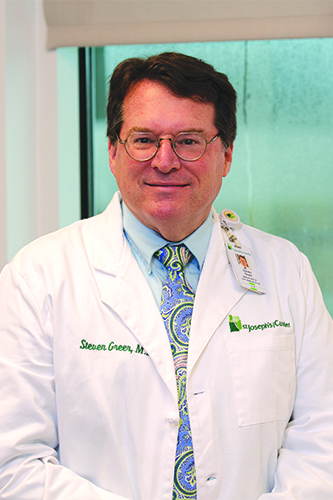Less Pain, More Gain
How to keep doing the activities you love with conservative treatments for joint pain
You may know the old joke about the man who goes to his doctor and says, “Doctor, it hurts when I do this.”
The doctor replies, “Then don’t do that.”
But if you have an activity you love—tennis with friends, running 5K’s, gardening, painting—and your joints make it too painful to do it, that punchline isn’t so funny.
Steven Greer, MD, with St. Joseph’s/Candler Physician Network – Bone, Joint & Muscle Care, doesn’t tell his patients to stop doing things.

“That’s not my job,” he says. “I feel our job as physicians is to help people do the things they want to do.”
Where To Begin
Your joints are your body’s shock absorbers. But if you have any type of arthritis, the joints may now be a source of pain—as well as swelling or stiffness—when you try to do physical activities.
Stopping those activities isn’t the answer. It could lead to deconditioning, which raises the risk for obesity and other conditions such as high blood pressure and diabetes. Weight gain, in turn, puts even more pressure on the joints.
Often, the best prescription is exercise.
“With many musculoskeletal issues, we can use your muscles to take the pressure off of your joints,” Dr. Greer explains. “I do a lot of exercise prescriptions. Walking is good for arthritis. Research has found that running is good at preventing arthritis—your body responds to running by making thicker cartilage for your joints.”
Pool therapy can also be effective for some patients.
“The buoyancy of the water takes the pressure off of the joints, so the exercises don’t hurt as much,” Dr. Greer says. “Also, moving underwater requires more of your muscles, making you stronger faster which then alleviates your pain faster.”
If you’re over the age of 45, Dr. Greer recommends that you check in with your primary care doctor before starting an exercise program
“Everyone is healthy enough to start a program, but it’s a matter of how you do it and what exercises are safe for you to start with,” he says. 
Supplemental Coverage
Dr. Greer can also employ medications, supplements and other conservative treatments to help strengthen joints and decrease pain. A compound of glucosamine and chondroitin has been shown to help about 60 percent of patients.
“These are basically what your body uses to make joint fluid and cartilage,” Dr. Greer says. “Your body uses them as building blocks, so they may take a month or more to fully work. But once they are back doing their favorite things, many of my patients are glad they tried this option.”
Dr. Greer can also administer steroid injections into the joint to alleviate arthritis pain. Another type of injection is known as viscosupplementation treatment, in which a thick fluid called hyaluronic acid acts as a coating for the cartilage that helps bones move together smoothly.
Other possible options include topical creams, anti-inflammatory supplements and chemical mixtures known as unsaponifiables that can reduce swelling. Sometimes just plain old acetaminophen can help.
“If something is really important to you—say tennis, for example—we’ll figure out ways to make it not hurt so much when you play,” Dr. Greer says. “You may not be able to play in the exact same manner that you used to—you may have to modify your serve or make other changes—but we’ll get you on the court with a racquet in your hand.”
An Early Start
Dr. Greer wants people to think of exercise as medicine early in their adult lives. This may not only prevent pain but will prepare patients for active lives into older age—and for after surgery.
“Once you have arthritis in your knee, if you are lucky enough to live a long time after that, you’re going end up needing a knee replacement,” he says. “That’s why it’s crucial to become active sooner rather than later, and to not let joint pain end your activities. You want to be in a position in life that if you do need surgery, you’ll be ready for it and you’ll recover well.”